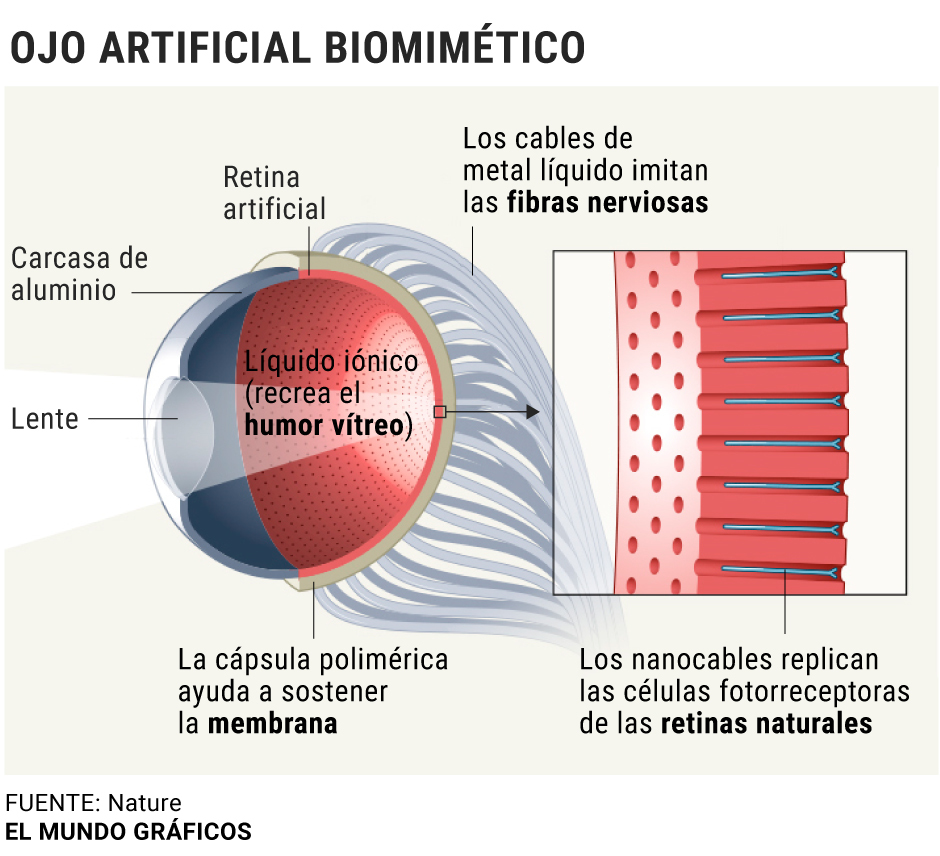- Science Nanotechnology, the invisible science that will build the 'superman'
- Research. 'A la carte' materials thanks to nanotechnology
The eye is one of the most sophisticated products of evolution, an evolutionary feat perfected from millions of years of adaptations. The human eye, for example, is a more complex and ingenious optical system than any artificial camera: the retina's dome shape naturally reduces the spread of light passing through the lens, allowing for quick adjustment and precise in focus.
Replicating this biological technology in a functional way is a huge technical challenge . Until now, attempts to adapt materials to a spherical surface on a submillimeter scale have limited the feasibility of artificial optical systems.
A team of researchers from the Hong Kong University of Science and Technology has presented the prototype of an electrochemical eye that manages to imitate this structure. That includes an innovative biomimetic retina that uses a set of nanometric sensors, which serve the same function as the millions of photoreceptor cells that the human eye possesses. According to its authors, this technique - described in the latest issue of the journal Nature - achieves a device with capabilities comparable to those of the human eye, such as field width and focus.
The structure designed by the Hong Kong researchers places the photosensors in the pores of an aluminum oxide (Al2O3) membrane, which replicates the function of the human retina . Thin and flexible cables, made of a liquid metal (an alloy of gallium and indium) and sealed in rubber tubes, transmit the signals collected by these sensors to external circuits.
Thus, the cables mimic the nerve fibers that connect the human eye to the brain. The artificial retina covers a spherical structure, a basin made of a silicone polymer and an indium (In) layer. The assembly allows an arrangement that optimizes the electrical contact between the liquid metal cables and the nanosensors.
The recreation of spherical synthetic eyes has multiple applications in robotics and in the development of visual prostheses , fields in which the need for a technology with a curved shape made it until now a challenge to use artificial devices. "I look forward to collaborating with biomedical researchers, especially those already working on visual prosthetics," says Zhiyong Fan, first author of the article.
"With these collaborations we hope to further improve our device, in terms of biocompatibility, stability and performance, so that in a few years our device can benefit the general public ," he adds.
One of the crucial elements of the artificial retina is the light-sensitive nanowire bundles, made of a material called perovskite . Although perovskite originally designated a mineral in its natural state, the term today refers to a type of hybrid material - organic and inorganic - extremely promising for various optoelectronic and photonic applications. This family of materials has a crystalline structure, which makes them absorb light very well and are very good conductors. In this case, they were made with lead iodide and formamidinium.
At the front is a lens combined with an artificial iris, made of aluminum coated with a tungsten film. The chamber is filled with an ionic liquid that mimics vitreous humor, the gel that fills the space between the lens and the retina in the human eye.
Almost like our sight
According to the authors, having recreated the design and structure of the human eye allows the device to achieve a wide field of view of 100 ° , close to approximately 130 ° of our eyes. Furthermore, the mimetic eye has a great ability to detect a wide range of light intensities, like its natural counterpart.
But the prototype, which is still in the proof of concept phase , has a fairly low resolution. Although the authors maintain that their design has the potential to improve exponentially in this regard, until achieving an even better resolution than that of the human eye.
"Currently the resolution is only 130 dots per inch (dpi), but in this work we have used a manual microneedle method to contact the photosensor of individual nanowires, so that each detection pixel is one micrometer apart," explains Fan. . "This means that the final resolution of our artificial retina could become greater than 10,000 dpi, with the assistance of an automated method."
In accordance with the criteria of The Trust Project
Know more- science
- Science and health
- Graphics
Covid-19British and Spanish, most concerned about coronavirus
By 2070, a third of the world's population will live in areas as hot as the Sahara
Climate crisis Melting ice in Greenland and Antarctica has increased sea level by 1.4 centimeters since 2003

